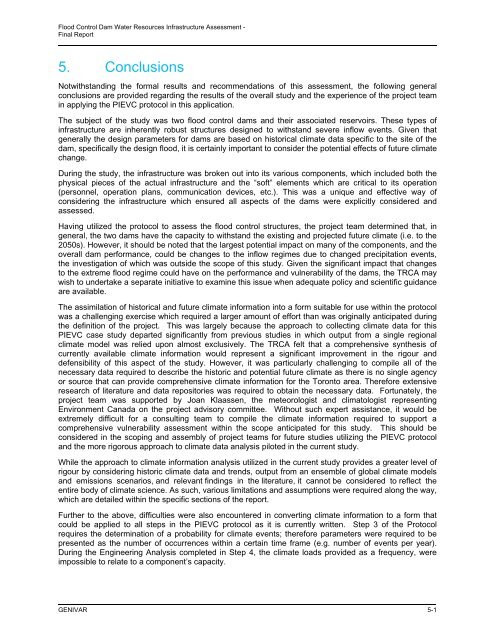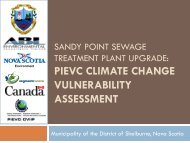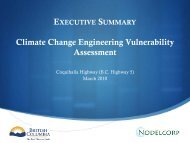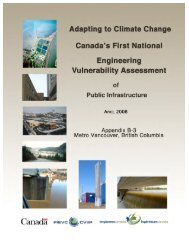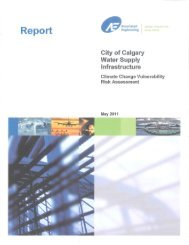Final Report - Vulnerability Committee
Final Report - Vulnerability Committee
Final Report - Vulnerability Committee
Create successful ePaper yourself
Turn your PDF publications into a flip-book with our unique Google optimized e-Paper software.
Flood Control Dam Water Resources Infrastructure Assessment -<strong>Final</strong> <strong>Report</strong>5. ConclusionsNotwithstanding the formal results and recommendations of this assessment, the following generalconclusions are provided regarding the results of the overall study and the experience of the project teamin applying the PIEVC protocol in this application.The subject of the study was two flood control dams and their associated reservoirs. These types ofinfrastructure are inherently robust structures designed to withstand severe inflow events. Given thatgenerally the design parameters for dams are based on historical climate data specific to the site of thedam, specifically the design flood, it is certainly important to consider the potential effects of future climatechange.During the study, the infrastructure was broken out into its various components, which included both thephysical pieces of the actual infrastructure and the “soft” elements which are critical to its operation(personnel, operation plans, communication devices, etc.). This was a unique and effective way ofconsidering the infrastructure which ensured all aspects of the dams were explicitly considered andassessed.Having utilized the protocol to assess the flood control structures, the project team determined that, ingeneral, the two dams have the capacity to withstand the existing and projected future climate (i.e. to the2050s). However, it should be noted that the largest potential impact on many of the components, and theoverall dam performance, could be changes to the inflow regimes due to changed precipitation events,the investigation of which was outside the scope of this study. Given the significant impact that changesto the extreme flood regime could have on the performance and vulnerability of the dams, the TRCA maywish to undertake a separate initiative to examine this issue when adequate policy and scientific guidanceare available.The assimilation of historical and future climate information into a form suitable for use within the protocolwas a challenging exercise which required a larger amount of effort than was originally anticipated duringthe definition of the project. This was largely because the approach to collecting climate data for thisPIEVC case study departed significantly from previous studies in which output from a single regionalclimate model was relied upon almost exclusively. The TRCA felt that a comprehensive synthesis ofcurrently available climate information would represent a significant improvement in the rigour anddefensibility of this aspect of the study. However, it was particularly challenging to compile all of thenecessary data required to describe the historic and potential future climate as there is no single agencyor source that can provide comprehensive climate information for the Toronto area. Therefore extensiveresearch of literature and data repositories was required to obtain the necessary data. Fortunately, theproject team was supported by Joan Klaassen, the meteorologist and climatologist representingEnvironment Canada on the project advisory committee. Without such expert assistance, it would beextremely difficult for a consulting team to compile the climate information required to support acomprehensive vulnerability assessment within the scope anticipated for this study. This should beconsidered in the scoping and assembly of project teams for future studies utilizing the PIEVC protocoland the more rigorous approach to climate data analysis piloted in the current study.While the approach to climate information analysis utilized in the current study provides a greater level ofrigour by considering historic climate data and trends, output from an ensemble of global climate modelsand emissions scenarios, and relevant findings in the literature, it cannot be considered to reflect theentire body of climate science. As such, various limitations and assumptions were required along the way,which are detailed within the specific sections of the report.Further to the above, difficulties were also encountered in converting climate information to a form thatcould be applied to all steps in the PIEVC protocol as it is currently written. Step 3 of the Protocolrequires the determination of a probability for climate events; therefore parameters were required to bepresented as the number of occurrences within a certain time frame (e.g. number of events per year).During the Engineering Analysis completed in Step 4, the climate loads provided as a frequency, wereimpossible to relate to a component’s capacity.GENIVAR 5-1


